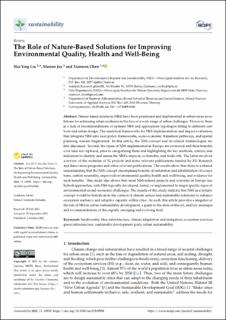| dc.description.abstract | Nature-based solutions (NbS) have been positioned and implemented in urban areas as solutions for enhancing urban resilience in the face of a wide range of urban challenges. However, there is a lack of recommendations of optimal NbS and appropriate typologies fitting to different contexts and urban design. The analytical frameworks for NbS implementation and impact evaluation, that integrate NbS into local policy frameworks, socio-economic transition pathways, and spatial planning, remain fragmented. In this article, the NbS concept and its related terminologies are first discussed. Second, the types of NbS implemented in Europe are reviewed and their benefits over time are explored, prior to categorizing them and highlighting the key methods, criteria, and indicators to identify and assess the NbS’s impacts, co-benefits, and trade-offs. The latter involved a review of the websites of 52 projects and some relevant publications funded by EU Research and Innovation programs and other relevant publications. The results show that there is a shared understanding that the NbS concept encompasses benefits of restoration and rehabilitation of ecosystems, carbon neutrality, improved environmental quality, health and well-being, and evidence for such benefits. This study also shows that most NbS-related projects and activities in Europe use hybrid approaches, with NbS typically developed, tested, or implemented to target specific types of environmental–social–economic challenges. The results of this study indicate that NbS as a holistic concept would be beneficial in the context of climate action and sustainable solutions to enhance ecosystem resilience and adaptive capacity within cities. As such, this article provides a snapshot of the role of NbS in urban sustainability development, a guide to the state-of-the-art, and key messages and recommendations of this rapidly emerging and evolving field. | en_US |

